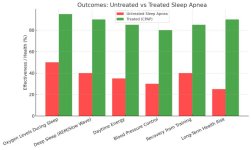eazy
VET
- Joined
- Nov 26, 2024
- Messages
- 644
At its core, sleep apnea is a disorder where a person’s breathing repeatedly stops and starts during the night. These pauses, called apneic events, last anywhere from 10 seconds to over a minute, and they can occur dozens or even hundreds of times in a single night. Although it may seem harmless at first glance, sleep apnea is far from just loud snoring or restless sleep. Left untreated, it can have profound effects on energy, health, and longevity.
Types of Sleep Apnea There are two main types:
Obstructive sleep apnea (OSA) and central sleep apnea (CSA). OSA is by far the most common. It occurs when the throat muscles relax too much during sleep, causing the airway to collapse or become blocked. Imagine trying to breathe through a straw while it’s being pinched shut—that’s essentially what’s happening. Central sleep apnea, on the other hand, is less common and stems from the brain failing to send the right signals to the muscles that control breathing. In some people, a mixture of both forms occurs, called complex sleep apnea.
Why Obstructive Sleep Apnea Happens
Several risk factors contribute to OSA. One of the biggest is excess tissue in the neck and throat area, which makes it easier for the airway to collapse. This is why people with thicker necks whether from body fat, muscle mass, or both are at higher risk. Obesity is a well established contributor, but even very muscular athletes can develop apnea if their airway is crowded by neck or throat size. When the airway narrows, air struggles to pass through, causing vibrations in the throat what we hear as snoring. When the airway closes entirely, oxygen levels in the blood drop, and the brain quickly rouses the sleeper, sometimes with a loud snort or gasp, to reopen the airway. These micro-awakenings may not fully wake the person, but they shatter deep, restorative sleep cycles.
How CPAP Works
The most effective treatment for obstructive sleep apnea is the CPAP machine, short for Continuous Positive Airway Pressure. A CPAP delivers a steady stream of pressurized air through a mask, essentially acting like a splint to keep the airway open. Instead of collapsing when the throat muscles relax, the airway stays inflated, allowing normal breathing throughout the night. With CPAP therapy, oxygen levels remain stable and the body can stay in deep sleep stages like REM, which are crucial for mental restoration and muscle recovery.
The Takeaway
Sleep apnea is more than snoring or restless nights. It’s a condition where the body literally starves for oxygen dozens of times a night, stressing the heart, disrupting hormones, and sabotaging recovery. The good news is that diagnosis and treatment especially with CPAP can restore normal breathing, protect long-term health, and even give a competitive edge through better recovery. Recognizing and addressing sleep apnea is not just about sleeping better, it’s about living stronger and longer.

By: RawCutlery IFBB PRO
Types of Sleep Apnea There are two main types:
Obstructive sleep apnea (OSA) and central sleep apnea (CSA). OSA is by far the most common. It occurs when the throat muscles relax too much during sleep, causing the airway to collapse or become blocked. Imagine trying to breathe through a straw while it’s being pinched shut—that’s essentially what’s happening. Central sleep apnea, on the other hand, is less common and stems from the brain failing to send the right signals to the muscles that control breathing. In some people, a mixture of both forms occurs, called complex sleep apnea.
Why Obstructive Sleep Apnea Happens
Several risk factors contribute to OSA. One of the biggest is excess tissue in the neck and throat area, which makes it easier for the airway to collapse. This is why people with thicker necks whether from body fat, muscle mass, or both are at higher risk. Obesity is a well established contributor, but even very muscular athletes can develop apnea if their airway is crowded by neck or throat size. When the airway narrows, air struggles to pass through, causing vibrations in the throat what we hear as snoring. When the airway closes entirely, oxygen levels in the blood drop, and the brain quickly rouses the sleeper, sometimes with a loud snort or gasp, to reopen the airway. These micro-awakenings may not fully wake the person, but they shatter deep, restorative sleep cycles.
How CPAP Works
The most effective treatment for obstructive sleep apnea is the CPAP machine, short for Continuous Positive Airway Pressure. A CPAP delivers a steady stream of pressurized air through a mask, essentially acting like a splint to keep the airway open. Instead of collapsing when the throat muscles relax, the airway stays inflated, allowing normal breathing throughout the night. With CPAP therapy, oxygen levels remain stable and the body can stay in deep sleep stages like REM, which are crucial for mental restoration and muscle recovery.
The Takeaway
Sleep apnea is more than snoring or restless nights. It’s a condition where the body literally starves for oxygen dozens of times a night, stressing the heart, disrupting hormones, and sabotaging recovery. The good news is that diagnosis and treatment especially with CPAP can restore normal breathing, protect long-term health, and even give a competitive edge through better recovery. Recognizing and addressing sleep apnea is not just about sleeping better, it’s about living stronger and longer.

By: RawCutlery IFBB PRO
